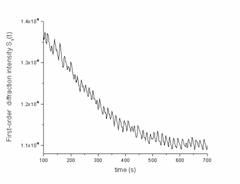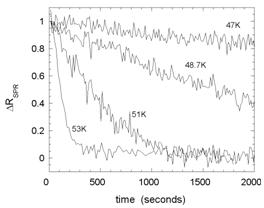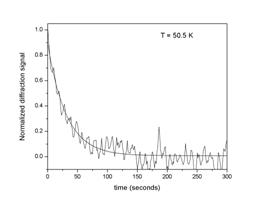Reports: AC5
45645-AC5 Classical and Quantum Diffusion of Hydrogen on Cu Surfaces: An Optical Diffraction Study Using Xe Density Gratings as Templates
Mass transport of Xe multi-layers on Cu(111) at low temperatures
Intralayer and interlayer transport play critical roles in thin film growth and fabrication of novel material structures. It remains a challenge to experimentally determine kinetic parameters that characterize these transport processes for a combination of host and guest materials of practical interest.
The decay of an adsorbate density grating at sub-monolayer coverage on a solid substrate has been successfully used to study the diffusive motion of a number of adsorbates on solid surfaces. When an adsorbate density grating is replaced with an adsorbate thickness grating with multi-layer coverage, the decay of the latter can be used to study intralayer and interlayer mass transport kinetics. The decay of a thickness grating can be measured either directly by following the diffraction of an optical beam from the grating or indirectly by following the amplitude of the grating-coupled surface plasmon polariton wave (SPPW) if the solid substrate such as Cu(111) supports SPPW.
Using a combination of optical diffraction and excitation/detection of an adsorbate-thickness-grating-coupled SPPW on Cu(111), we studied the mass transport of Xe multi-layers on Cu(111) at low temperatures (from 45 to 53 K). An SPPW is an electromagnetic wave confined at the interface between a metal (εm = εm' + i εm) and a transparent material (εs) with a well-defined wave-vector q = (2π/λ)(εmεs/(εm+εs))1/2. We excite the surface-plasmon polariton wave on Cu(111) by coupling an incident He-Ne laser beam to a multi-layer Xe thickness grating, with spatial period of a = 5.45 μm, preformed on the Cu surface. The reflectance of the laser beam is maximally attenuated at incidence angle given by sinθSPR = (εm'εs'/(εm'+εs'))1/2 - λ/a (typically known as SPR or surface-plasmon resonance effect) with the depth of the attenuation given by ΔR ~ (d1/λ)2, where d1 is the modulation depth of the Xe thickness (multilayer) grating. At elevated temperatures, d1 diminishes with time due to intralayer and interlayer transport and desorption from the topmost surface. Fig. 1 shows the decay of the depth of SPR from a Xe multilayer grating on Cu(111) at 53K
Fig. 2 shows the decay of the first-order diffraction of a cw probe laser at 0.532 µm from the same Xe multilayer grating.
A comparison of Fig 1 and 2 shows that the measurement of the SPR depth yields the same kinetic information as that of the first-order optical diffraction from a dielectric multilayer grating on Cu(111).
Fig. 3 shows a set of decay curves for SPR depths from Xe multilayer gratings on Cu(111) as a function of surface temperature.
Fig. 4 shows the Arrhenius plot of the decay rates (obtained by fitting the decay curves in Fig. 3 with single exponential functions),
The activation energy that dominates the decay kinetics is Ea = 3.5 kcal/mol or 150 meV/atom. Ths value is high for Xe intralayer diffusion, suggesting that the decay is rate-limited by interlayer mass transport and/or desorption. To further prove this proposition, we performed a set of optical diffraction measurements on Xe multilayer grating with periodicity a' = 0.38 µm. If the decay of a Xe multilayer grating is dominated by intralayer mass transport, the decay time constant should be proportional to a2. By reducing the grating periodicity from a = 5.45 µm to a' = 0.38 µm, the decay time constant should be reduced by a factor of (a/a')2 = 317. Fig. 5 shows the decay of the first-order optical diffraction of the cw probe laser at 0.532 µm off a Xe grating with a' = 0.38 µm at T ~ 51K. The decay time constant of ~ 30 seconds is only reduced from ~ 700 seconds (Fig. 3) by a factor of 23, much less than the expected factor of 317.
This confirms that the decay of Xe multi-layer gratings on Cu(111) from 47 to 53K is indeed dominated by interlayer mass transport.
Gray and Zhu measured the thermal desorption kinetics of Xe multilayers and found the activation energy for those Xe above the first monolayer on Ni(111) (similar to Cu(111)) was also characterized by an activation energy of 3.5 kcal/mol (unpublished). This suggests that both the thermal desorption and the decay of Xe multi-layer gratings is rate-limited by the detachment of Xe from step edges, instead of surface diffusion or detachment from the terraces.









